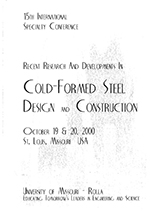Session Dates
19 Oct 2000
Abstract
An experimental investigation of cold-formed channels subjected to combined bending and web crippling is described in this paper. A series of tests was performed on unlipped channels rolled from high strength structural steel sheets having nominal plate thickness up to 6 mm, and a maximum web slenderness value of 45. This value is considerably lower than the intended web slenderness values used in the Australian/New Zealand Standard (AS/NZS 4600, 1996) and the American Iron and Steel Institute (AISI, 1996) Specification for cold-formed steel structures. In the past, the typical thickness of cold-formed steel members was less than 3 mm, and this was due to the limitations of the cold-forming technology in the 1980s. The design rules in the AS/NZS 4600 and the AISI Specification for members subjected to combined bending and web crippling are mainly based on test results having plate thickness less than 3 mm with web slenderness values greater than 45. Therefore, the appropriateness of the design rules for members having plate thickness greater than 3 mm is investigated in this paper. The specimens were tested at various lengths using the Interior-One-Flange (lOF) loading condition specified in the AS/NZS 4600 and the AISI Specification. The test strengths are compared with the design strengths obtained using the AS/NZS 4600 and the AISI Specification. Generally, it is shown that the specifications conservatively predicted the strengths of the tested unlipped channels subjected to combined bending and web crippling.
Department(s)
Civil, Architectural and Environmental Engineering
Research Center/Lab(s)
Wei-Wen Yu Center for Cold-Formed Steel Structures
Meeting Name
15th International Specialty Conference on Cold-Formed Steel Structures
Publisher
University of Missouri--Rolla
Document Version
Final Version
Rights
© 2000 University of Missouri--Rolla, All rights reserved.
Document Type
Article - Conference proceedings
File Type
text
Language
English
Recommended Citation
Young, Ben and Hancock, Gregory J., "Experimental Investigation of Cold-formed Channels Subjected to Combined Bending and Web Crippling" (2000). CCFSS Proceedings of International Specialty Conference on Cold-Formed Steel Structures (1971 - 2018). 1.
https://scholarsmine.mst.edu/isccss/15iccfss/15iccfss-session2/1
Experimental Investigation of Cold-formed Channels Subjected to Combined Bending and Web Crippling
An experimental investigation of cold-formed channels subjected to combined bending and web crippling is described in this paper. A series of tests was performed on unlipped channels rolled from high strength structural steel sheets having nominal plate thickness up to 6 mm, and a maximum web slenderness value of 45. This value is considerably lower than the intended web slenderness values used in the Australian/New Zealand Standard (AS/NZS 4600, 1996) and the American Iron and Steel Institute (AISI, 1996) Specification for cold-formed steel structures. In the past, the typical thickness of cold-formed steel members was less than 3 mm, and this was due to the limitations of the cold-forming technology in the 1980s. The design rules in the AS/NZS 4600 and the AISI Specification for members subjected to combined bending and web crippling are mainly based on test results having plate thickness less than 3 mm with web slenderness values greater than 45. Therefore, the appropriateness of the design rules for members having plate thickness greater than 3 mm is investigated in this paper. The specimens were tested at various lengths using the Interior-One-Flange (lOF) loading condition specified in the AS/NZS 4600 and the AISI Specification. The test strengths are compared with the design strengths obtained using the AS/NZS 4600 and the AISI Specification. Generally, it is shown that the specifications conservatively predicted the strengths of the tested unlipped channels subjected to combined bending and web crippling.



